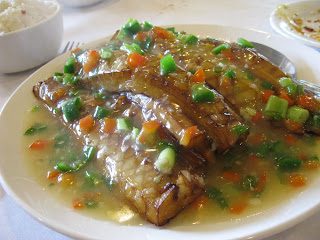Chicago’s Chinatown is great in the following ways:*
1) There is a minimum of two really good restaurants. I only ever go to two of them, and my occasional forays into other restaurant territory have been disappointing. But I only need two restaurants, because each one has a menu the approximate length of Beowulf.
2) Unlike Philadelphia’s Chinatown, Chicago’s is not weirdo-hobo-land. No offense to the homeless, but you know those really weird hobos – the ones who have one giant dreadlock and mutter incoherent things while banging their feet against their ears? In Philadelphia, Chinatown is their main hangout.
3) Unlike Philly’s, Chicago’s Chinatown is not filthy as an unwashed hipster. Instead, it is clean as a washed hipster.
4) The best bubble tea of my life at Joy Yee. And I have eaten/drunk a great deal of bubble tea over the years.
The two restaurants I patronize, Lao Sze Chuan and Lao Beijing, are owned by the same chef, Tony Hu, who also operates several other regional-style restaurants in Chicago’s Chinatown.
Fortunately for this blog and my belly, each Lao offers several vegetarian eggplant dishes, of which I have sampled four (and three of which went unphotographed, pre-blog). In the ongoing Eggplants of Chinatown series, I’ll provide photos and descriptions of my eggplant encounters as I gradually sample every vegetarian eggplant dish in these two restaurants.
It would sound more impressive if I said, “every eggplant dish in Chinatown,” or “every eggplant dish in Chicago.” Now THAT would be a blog, like Julie Powell's food quest. But no, alas, I am tired of being disappointed by restaurants that are not owned by Tony Hu. So I’m sticking to Lao for nao.
Today I went for lunch at Lao Sze Chuan, where eggplants abound.
 |
| The restaurant's cute interior. |
I asked the waitress for a recommendation. She suggested the eggplant with garlic sauce, which was too boring-white-person-eating-Chinese-food for me, so I rudely ignored her and ordered the Chongqing style. It came out looking like this:
The eggplants, as you can see, have been peeled, etched with a cross-hatch pattern, and deep fried whole. They are topped with a mild white sauce and fresh hot peppers.
While this dish looked beautiful, it wasn’t quite as delicious as I expected. There were two shortcomings. First, the sauce was a bit boring, tasting of nothing but salt and sugar (no garlic, ginger, chili, soy, etc.). And second, the eggplants gradually exuded so much oil that I ended up meticulously spooning an entire dishful of grease from the surface. I believe I ended up consuming more oil than jasmine tea. And by the time I brought the dish home, the eggplants had oozed so much oil that there was a layer half an inch thick floating on the surface. This is the problem, I find, with eggplants cooked in a deep fryer. So maybe I should have ordered the boring-white-person garlic sauce after all, which I know from past visits to be delicious and not terribly greasy -- but then again, it isn’t nearly as photogenic as these long, squid-like eggplant pieces.
* I like to make lists in all my entries because:
1) As a graduate student, list-making has become one of my primary life skills.
2) Humor is made easy by surprising readers with an unexpected list item.
3) Fishcakes.




























